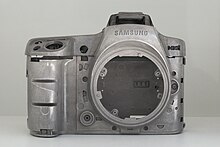
Back سبيكة مغنيسيوم Arabic Magnesiumlegierung German Aleaciones de magnesio Spanish آلیاژهای منیزیم Persian Magnesiumseokset Finnish Մագնեզիումի համաձուլվածքներ Armenian マグネシウム合金 Japanese Magnesiumlegering Dutch Stopy magnezu Polish Магнієві сплави Ukrainian
This article needs additional citations for verification. (August 2009) |


Magnesium alloys are mixtures of magnesium (the lightest structural metal) with other metals (called an alloy), often aluminium, zinc, manganese, silicon, copper, rare earths and zirconium. Magnesium alloys have a hexagonal lattice structure, which affects the fundamental properties of these alloys. Plastic deformation of the hexagonal lattice is more complicated than in cubic latticed metals like aluminium, copper and steel; therefore, magnesium alloys are typically used as cast alloys, but research of wrought alloys has been more extensive since 2003. Cast magnesium alloys are used for many components of modern automobiles and have been used in some high-performance vehicles; die-cast magnesium is also used for camera bodies and components in lenses.
Practically, all the commercial magnesium alloys manufactured in the United States contain aluminium (3 to 13 percent) and manganese (0.1 to 0.4 percent). Many also contain zinc (0.5 to 3 percent) and some are hardenable by heat treatment. All the alloys may be used for more than one product form, but alloys AZ63 and AZ92 are most used for sand castings, AZ91 for die castings, and AZ92 generally employed for permanent mold castings (while AZ63 and A10 are sometimes also used in the latter application as well). For forgings, AZ61 is most used, and here alloy M1 is employed where low strength is required and AZ80 for highest strength. For extrusions, a wide range of shapes, bars, and tubes are made from M1 alloy where low strength suffices or where welding to M1 castings is planned. Alloys AZ31, AZ61 and AZ80 are employed for extrusions in the order named, where increase in strength justifies their increased relative costs.[1][full citation needed]
Magnox (alloy), whose name is an abbreviation for "magnesium non-oxidizing", is 99% magnesium and 1% aluminium, and is used in the cladding of fuel rods in magnox nuclear power reactors.
Magnesium alloys are referred to by short codes (defined in ASTM B275) which denote approximate chemical compositions by weight. For example, AS41 has 4% aluminum and 1% silicon; AZ81 is 7.5% aluminium and 0.7% zinc. If aluminium is present, a manganese component is almost always also present at about 0.2% by weight which serves to improve grain structure; if aluminum and manganese are absent, zirconium is usually present at about 0.8% for this same purpose. Magnesium is a flammable material and must be handled carefully.
- ^ J. T. Black; Ronald A. Kohser (2012). DeGarmo's Materials and Processes in Manufacturing, 11th Edition. Wiley. ISBN 978-1-118-16373-3.
© MMXXIII Rich X Search. We shall prevail. All rights reserved. Rich X Search